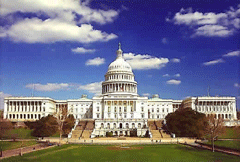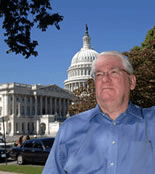Greening the Capitol
Air Date: Week of June 20, 2008

The US House of Representatives and the Senate are located in the US Capitol Building in Washington, DC. (Courtesy of Architect of the Capitol)
By the end of this year, the U.S. House of Representatives will be carbon neutral and aims to be a model for sustainability. The House Chief Administrative Officer Dan Beard talks with host Bruce Gellerman about his efforts to green the nation’s Capitol.
Transcript
GELLERMAN: So, how many Congressmen does it take to screw in an energy efficient light bulb? Well, last year House majority leader Nancy Pelosi set a goal for the House of Representatives to be carbon neutral by the end of the 110th Congress, just 6 months away. So how are lawmakers doing? Dan Beard is the House Chief Administrative Officer and he’s in charge of greening the Capitol. He joins me from our studio on the hill.
Mr. Beard, welcome to Living on Earth.
BEARD: Thank you very much. It’s wonderful to be with you.
GELLERMAN: So how’s the greening going?
BEARD: It’s going very well. As you said in your introduction, we set a goal of being carbon neutral in our operations by December of this year and we will make it, I think we will make it several months in advance of that. And the second goal we set was to reduce our energy consumption by 50 percent over the next ten years, five percent a year for ten years. And the first year we reduced our energy consumption by six percent so we feel pretty good about the progress we’re making.
GELLERMAN: Well, it was George Washington who laid the cornerstone for the Capitol Building way back in 1793 and I know it’s gone through many changes since then, it’s been burned down, it’s been expanded, but it’s still an old, drafty building as I recall—I used to work there.
BEARD: Yes, it’s very old and very drafty. The House of Representatives has six million square feet of office space. Our half of the Capitol is the oldest building, 1793, and it gives you an idea of the kind of antiquated infrastructure we have to work with but you can do it if you have a commitment to it.

Dan Beard is the Chief Administrative Officer for the US House of Representatives. Part of his job is to make the House of Representatives be carbon neutral by the end of this year. (Courtesy of the US House of Representatives)
GELLERMAN: So how do you do it? I mean you’ve got this old power plant that’s dedicated to powering the Capitol Building and historically almost half the power comes from that facility and it comes from burning coal.
BEARD: We quichly developed a plan. We assessed and calculated our carbon footprint. And the first thing we did was to decide to purchase electric power only from renewable sources. The second thing we did was direct the architect of the Capitol who runs the Capitol power plant to burn only natural gas to meet our needs. And then the last thing we did for this year anyway is we bought some carbon-offset credits and retired them. And all three of those together will make us together will make us carbon neutral well before our deadline of December.
GELLERMAN: So, solar panels on the top of the Capitol Dome?
BEARD: Uh, not quite. But we are working to light the Capitol Dome with energy efficient lighting, LED lights. The Capitol is a symbol of democracy, it’s one of the most recognized buildings in the world, and there’s something very satisfying to think that it’s, it’ll be lit with energy efficient lights and our operating costs, yearly operating costs for lighting the Dome, will decrease by 50 percent as a result of installing those lights. Everything that we’re doing saves money. It ultimately results in savings to the taxpayer and I think that that’s the right thing to do. I think it’s irresponsible not to do it. For example, compact fluorescent light bulbs, you know, we directed our facilities manager to replace 30,000 light bulbs in the House of Representatives. We will save 120,000 dollars a year on our lighting bill as a result of installing those compact fluorescent light bulbs—Over a ten year period, over 1.2 million dollars.

The US House of Representatives and the Senate are located in the US Capitol Building in Washington, DC.(Courtesy of Architect of the Capitol)
The savings are real and they’re very significant. And it takes place very quichly: in the case of compact fluorescent light bulbs, it takes four months for them to repay the cost in terms of energy savings and on the fifth month you’re making money. There are lots of other things that you can do, such as, we have reduced our run time on our air conditioning system. Our buildings are open 24/7 but we have turned up the air conditioning—I think that’s the right phrase, or turned it down—we’ve made it warmer in the middle of the night and we just changed our run times and we got a 15 percent savings in our electric bills. We’ve got a lot of things to do in front of us, there’s a lot of things we could be doing, but we’re very excited about it.
GELLERMAN: Well, lawmakers are a lot like an army, they operate on their stomach. You serve a lot of food there. What, if anything, are you doing to green your cafeterias?
BEARD: We serve 230,000 meals a month. All of those food service facilities are now green. We have banned Styrofoam and plastic and all of the utensils you use—the plates, the cups, all the flatware, everything—is compostible. And the result is that we have reduced our contributions to landfills by 50 percent. Also, our food service operation is emphasizing locally grown products within a 150 mile radius of the capital, so that saves on transportation costs for food items and the food is fresher.
GELLERMAN: But it seems it takes more than physical changes. You’ve got a lot of people working there, you gotta change behaviors.
BEARD: I think that’s probably our biggest challenge. We’ve switched now to only using 100 percent post-consumer recycled paper. We did a contract with Zipcars and we now have Zipcars located in our garages and those are available to our staff. But their daily lives are changing too. I mean we are trying to move computer servers out of individual offices because what we found is by having servers in offices they tend to heat up the offices so much then you have to turn up the air-conditioning to cool it and you know you’ve just created a larger problem.
GELLERMAN: Well Mr. Beard, thank you so very much. I appreciate it.
BEARD: I appreciate it and anytime.
GELLERMAN: Dan Beard is Chief Administrative Officer of the US House of Representatives.
Though the Capitol building may be growing ever more green – just down the street at the White House there’s a different perspective. The President says we’re addicted to oil and should drill off our coast to get it. So we leave you this week with a song from the Capitol Steps.
Links
Living on Earth wants to hear from you!
Living on Earth
62 Calef Highway, Suite 212
Lee, NH 03861
Telephone: 617-287-4121
E-mail: comments@loe.org
Newsletter [Click here]
Donate to Living on Earth!
Living on Earth is an independent media program and relies entirely on contributions from listeners and institutions supporting public service. Please donate now to preserve an independent environmental voice.
NewsletterLiving on Earth offers a weekly delivery of the show's rundown to your mailbox. Sign up for our newsletter today!
 Sailors For The Sea: Be the change you want to sea.
Sailors For The Sea: Be the change you want to sea.
 The Grantham Foundation for the Protection of the Environment: Committed to protecting and improving the health of the global environment.
The Grantham Foundation for the Protection of the Environment: Committed to protecting and improving the health of the global environment.
 Contribute to Living on Earth and receive, as our gift to you, an archival print of one of Mark Seth Lender's extraordinary wildlife photographs. Follow the link to see Mark's current collection of photographs.
Contribute to Living on Earth and receive, as our gift to you, an archival print of one of Mark Seth Lender's extraordinary wildlife photographs. Follow the link to see Mark's current collection of photographs.
 Buy a signed copy of Mark Seth Lender's book Smeagull the Seagull & support Living on Earth
Buy a signed copy of Mark Seth Lender's book Smeagull the Seagull & support Living on Earth

